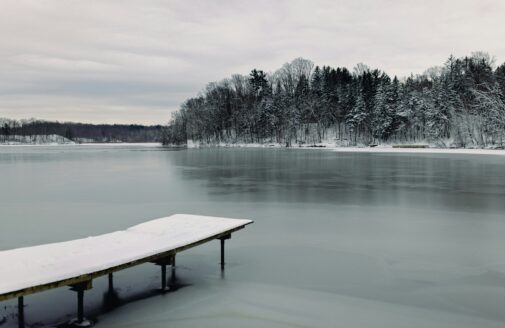What is permafrost?
Centuries-old frozen soil is under threat from rapid warming
Arctic permafrost landscape.
photo by Tim Nieland
Thinking about climate change usually brings to mind dramatically melting ice caps and rising sea levels, but there’s another threat that’s caught the attention of climate scientists for its potential to be equally as disastrous—thawing permafrost.
Located anywhere between a few centimeters to 4,900ft below the Earth’s surface, permafrost is soil composed of sand, gravel, organic matter, and ice that has been frozen for at least two consecutive years. Some has been frozen for centuries or even millennia, and it’s this ancient permafrost in the Arctic that holds the greatest significance for climate change.

Current extent of Arctic and boreal permafrost (blue).
map by Greg Fiske
Arctic permafrost stretches across Alaska, Scandinavia, Russia, Iceland, and Canada, and can be found beneath the Arctic Ocean, the Arctic tundra, alpine forests, and boreal forests. It covers 15% of the land in the Northern Hemisphere and 3.6 million people live atop it. Scientists estimate that Arctic permafrost contains 1.4 trillion tonnes of carbon, an amount more than double what is currently in the Earth’s atmosphere. That carbon sink is stable as long as it stays frozen, but when it thaws, soil microbes break down the organic matter in permafrost and release carbon dioxide and methane into the atmosphere, increasing the rate of climate change.
In many places, forests, plants, and peat act as protective insulation for Arctic permafrost. This insulation helps keep carbon-storing organic matter, like plants and animals, as well as bacteria and archaea, frozen in the permafrost. However, climate change is already causing the Arctic to warm three to four times faster than the rest of the planet.
In addition to rapid warming speeding decay, it also strips back permafrost’s protective layers with increasing fires and heavy summer rains that burn and erode away top soil layers, further accelerating thaw. In some places, permafrost thaws so abruptly that the ground can collapse. Developing infrastructure that requires deforestation and underground pipes further exposes permafrost to warming. Additionally, as sea ice melts, coastal Arctic permafrost is exposed to warmer waters. The combined result is extensive permafrost thaw across the region.

graphic by Nichole Chapman
Researchers have been studying permafrost thaw to determine the size of the threat it poses. Methods such as placing soil moisture sensors in strategic locations and examining soil cores collected by drilling holes into the soil to document the different layers of permafrost help gauge the rate and extent of thaw.
In a recent TEDTalk, Dr. Sue Natali, Woodwell’s Arctic program director and senior scientist, cautioned that, “By the end of this century, greenhouse gas emissions from thawing permafrost may be on par with some of the world’s leading greenhouse-gas-emitting nations.”
There are already visible signs of vast permafrost thaw in the Arctic. Since ice is an essential part of the ground’s structural integrity, the soil becomes unstable when it thaws. This leads to dangerous situations like landslides, sinkholes, and destabilized infrastructure that threaten millions of people. Remote communities are particularly impacted, losing access to roads and sources of freshwater.

Coastal erosion due to permafrost thaw.
photo by Chris Linder
For both the carbon it threatens to release, and the destabilizing impacts it has on Arctic residents, permafrost thaw is a serious threat. One that, as the Arctic continues to warm, demands urgent attention and remediation.
Until now, that attention has been slow in coming. Read about why combatting permafrost thaw is such a complex issue in part two of our Permafrost series: “The critical missing expense in global climate budgets.”
Latest in Arctic

- In The News








